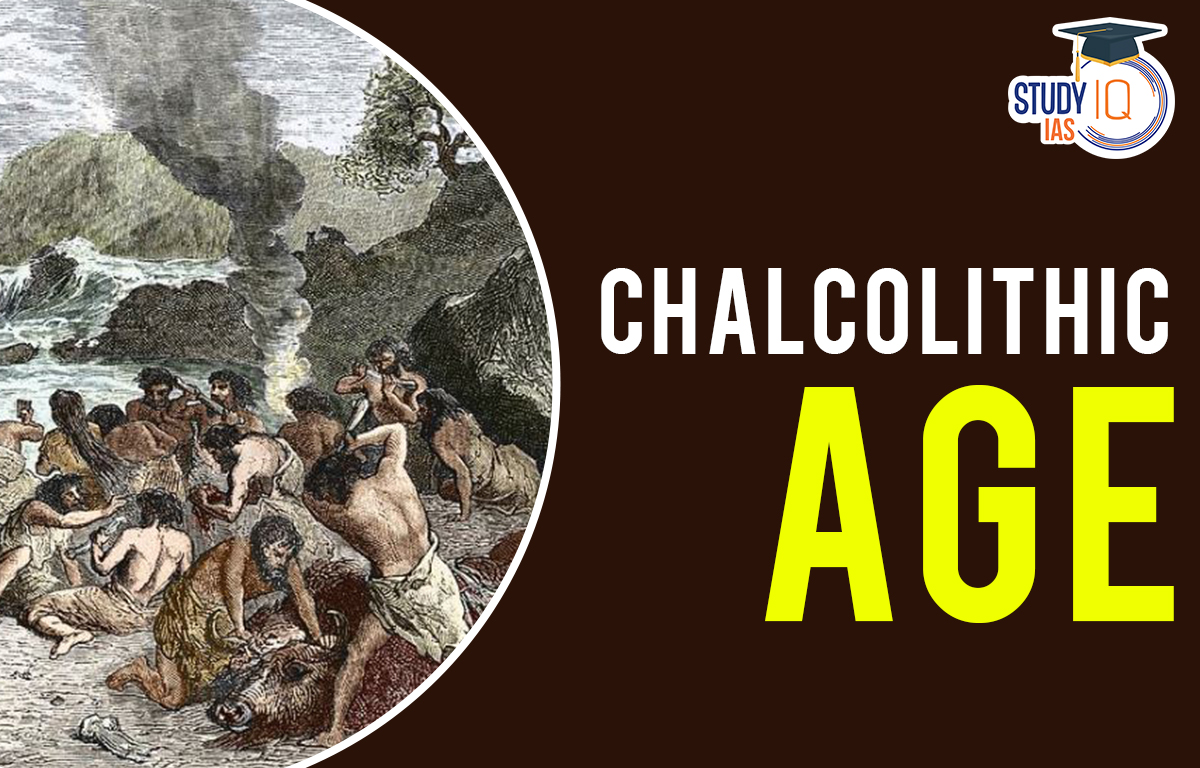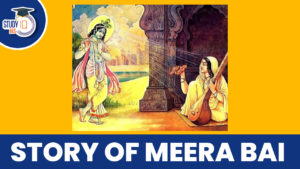Table of Contents
Chalcolithic Age
The Chalcolithic Period, also known as the Copper Age, Eneolithic, or Aeneolithic, is a historical era that is now included in the Neolithic time. Around the time of the Chalcolithic period, people started using metal and stone weapons. The first metal utilised by people at this time was copper. This time period is referred to as the Bronze Age in many regions of the globe. You will learn about Chalcolithic Age (Stone Copper Age) in this essay, which will help you prepare for the UPSC Civil Service Exam using the Ancient History of UPSC Syllabus.
Read about: South Indian Dynasties
Chalcolithic Period History (3000 BCE – 500 BCE)
The Greek words “khalkos” and “lthos,” which mean “copper” and “stone,” respectively, and refer to the Copper Age, are combined to form the name Chalcolithic. Several cultures used metal, mainly copper and low-grade bronze, after the Neolithic Age. A culture founded on the use of copper and stone was called Chalcolithic, which means “stone-copper Phase.”
In India, it ran from roughly 2000 BC to 700 BC. Although it was more prevalent in many locations during the Pre-Harappan era, this culture was also present during the Post-Harappan period. The vast bulk of people resided in rural communities close to hills and rivers. The Chalcolithic culture is linked with farming communities such as Kayatha, Ahar or Banas, Malwa, and Jorwe.
The Chalcolithic Age inhabitants used a variety of pottery styles, one of which is known as black-and-red pottery and appears to have been used frequently starting around 2000 B.C. It was occasionally tossed on a wheel and painted with white linear patterns.
Read about: Sangam Literature
Chalcolithic Age Characteristics
A significant social and cultural transformation occurred during the Copper Age. Not all cultures started this process at the same time or in the same way, it is important to note. Some individuals hardly ever use metal. Between Neolithic farmers who used stone tools and metal-obsessed Bronze Age civilizations, the Chalcolithic era, also known as the Copper Age, existed.
They were colonial pioneers who mainly lived close to mountains and rivers. The Harappan civilization was present during this time. Rural settlements developed all over the globe as a result of people cultivating crops like wheat, rice, and bajra as well as domesticating animals like cows, pigs, sheep, and goats. There is evidence that humans in the Bronze Age raised different pulses, including lentil, grass pea, and black gramme.
The two most prevalent hard materials used to create various kinds of weapons were bronze and copper. The societal development of the Bronze Age is well documented in writing. World-wide, Bronze Age rock drawings known as petroglyphs have been discovered. Examples that come to mind are the petroglyphs in Tanum, Sweden.
Read about: Later Vedic Period
Chalcolithic Age Features
The people of the Chalcolithic Age relied on gardening, fishing, and hunting for their food. A major occupation was hunting. Sheep, buffalo, goat, cattle, and pigs were raised and killed for food. Additionally, camel bones have been found. People consumed beef, but no signs of consuming pork were found. The Navdatoli residents grew flax and ber. Black cotton soil was used to produce cotton. There are also indications of rice farming. This proves they consumed seafood and rice. In contrast to Western India’s barley, eastern India produced rice.
Barley and wheat, lentil, bajra, jowar, ragi millets, green pea, and green and black grame were the most significant crops produced. Metals, including copper and its alloys, were used to make knives, axes, fishing lines, chisels, pins, and rods. Different types of pottery were used by people in the Chalcolithic era. They made a lot of pottery that was black and crimson. Pottery with an ochre hue was also utilised. Along with pots and copper objects, people interred their deceased in the floors of their homes from north to south.
Read about: Rig Vedic Period
Chalcolithic Age Important Culture
1. Ahara-Banas Culture
Aahar, Balthal, Gilund, and other locations close to the Banas River are examples of Ahar-Banas Culture places in Rajasthan. The identifying characteristic is the black and scarlet clothing.
2. Kayatha Culture
The primary characteristic of this Rajasthani hamlet close to Chambal and its tributaries is the robust red slipped ware with chocolate designs.
3. Malwa Culture
The Chalcolithic settlement of Narmada and its streams is one of the most significant. Diamabad, situated on the Pravara River’s left bank, is the most important Chalcolithic site. Daimabad, Inamgaon, Kayatha, Nagda, Vidisha, Eran, Mandsaur, and Navdatoli are some of the most significant Malwa cultural sites (near Maheshwar). A huge defensive wall and a moat have been found at Eran.
4. Savalda Culture
The well-known locations are in the Dhule region of Maharashtra.
5. Prabhas & Rangpur Culture
They both come from the Harappan civilization. The distinctive feature of this civilization is its polished red ware.
6. Jorwe Culture
On the Godavari River’s banks in Maharashtra’s Ahmednagar region is the village and archaeological site of Jorwe. Under the supervision of Hasmukh Dhirajlal Sankalia and Shantaram Bhalchandra Deo, this site was first explored in 1950–1951. Many chalcolithic sites from the Jorwe culture (c. 1300-700 BCE) have been found in Madhya Pradesh, Maharashtra, and other regions.
Read about: Sangam Period
Chalcolithic Age Art and Crafts
The Chalcolithic civilization is well-known for its predominantly red and orange wheel-made pottery. Pottery was embellished with a variety of shapes and linear motifs, most often in black paint. Designs included flowers, creatures, plants, and birds. Pottery in black and scarlet was produced for the first time.
People in Madhya Pradesh, Maharashtra, and Bihar produced channel-spouted vessels, dishes on stand, and bowls on stands. The inhabitants of the Chalcolithic Age were expert coppersmiths, ivory carvers, lime producers, and terracotta craftspeople. Semi Ornaments were made from precious jewels and stones like agate, jasper, chalcedony, and carnelian. People were adept at sewing and spinning. Maharashtra has flax, cotton, and silk thread available.
Read about: Gupta Empire
Chalcolithic Age Painting
The paintings from this time period show the association, interaction, and reciprocal trade of needs between the cave dwellers in this region and the established agricultural communities of the Malwa plains. Motifs like cross-hatched squares and lattices are commonly found in both chalcolithic rock paintings and ceramics. Tools made of metal and potteries are also on exhibit. However, these paintings lack the vivacity and vitality of previous eras.
The Jogimara caves in the Ramgarh hills of Chhattisgarh’s Surguja region contain some paintings from the later era. These were supposedly drawn around 1000 BCE. In the Chhattisgarh region of Kanker, you can find caves like the sanctuary of Udkuda, Garagodi, Khaperkheda, Gotitola, Kulgaon, and others. These houses feature representations of a more affluent and sedentary lifestyle, including human figures, animals, palm prints, bullock carts, and other objects.
Read about: Mauryan Empire
Chalcolithic Period Housing System
The Chalcolithic inhabitants of Harappa used bricks frequently, but no remains of burned or baked brickwork have been found. Simple rectangular or circular shapes made up the homes’ exteriors. Houses were constructed of mud and plastered with lime and bovine excrement. There were some multi-roomed homes among the mostly one-room homes. In the centre of the village, there are large mud houses with five rooms: four rectangular and one circular. Inamgaon is home to ovens and circular pit homes.
Read about: Rashtrakuta Dynasty
Chalcolithic Age Significance
The chalcolithic area covered the entire nation, with the exception of the alluvial region and large amounts of forest. Most people resided close to hills and waterways. Microlithic tools made of stone and metal were used. They had a talent for dissolving. The use of painted ceramics was new to them. They all used pots that were turned by a wheel in black and scarlet.
They were used for cooking, preserving, drinking, and eating. There is proof that lota and thali were used. When the Neolithic period gave way to the Chalcolithic, it was referred to as Neolithic-Chalcolithic. Colonization by the Chalcolithic inhabitants. In Peninsular India, there was a sizable hamlet where there was extensive cereal farming. Rice, lentils, wheat, and barley were all produced.
The main foods were fish and rice. Kayatha, Inamgaon, and Eran residents were wealthy, while Chirand and Pandi Rajar Dhibi residents were impoverished. In Maharashtra, the dead were buried north-south, whereas in South India, they were buried east-west.
Read about: Tripartite Struggle
Chalcolithic Age Limitation
Due to the fact that they only used domestic animals for food and not for milk, Chalcolithic people were unable to completely utilise domestic animals (they believed that milk was only for the young of animals). They did very little farming. They had no access to a plough or a hoe because they resided in a region with black cotton soil that needed iron tools for cultivation.
The Chalcolithic period was brief. There are signs of a significant number of buried children, which points to epidemic outbreaks and malnutrition. People couldn’t effectively use the stronger metal bronze because they didn’t know how to mix two metals. Copper had its own set of limitations and a finite quantity.
Read about: Asiatic Society
Chalcolithic Period UPSC
Metals were first used in the Chalcolithic or Eneolithic era, with copper being the first. Stone and copper are both used in chalcolithic architecture. The Copper Age, which spanned from 1800 to 800 BC, is thought to have been the earliest instance of human use of metal. So, between the Stone Age and the Metal Age, the Chalcolithic era served as a transitional time. During this period, copper tools were becoming more common and stone tools were becoming less common. To know more about Buddhism candidates must visit the official website of StudyIQ UPSC Online Coaching for UPSC Exam preparations
Read about: Indus Valley Civilization


 Battle of Plassey, History, Causes, Impa...
Battle of Plassey, History, Causes, Impa...
 Story of Meera Bai and Her Devotion For ...
Story of Meera Bai and Her Devotion For ...
 Desert Climate, Distribution, Climatic C...
Desert Climate, Distribution, Climatic C...





















